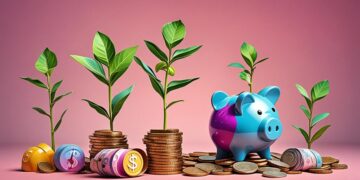The evolution of sustainable investments in Australia and their financial implications

The Shift Towards Responsible Investing in Australia
In recent years, Australia has witnessed a significant shift in investment practices, leaning towards a more sustainable approach. Investors are increasingly recognizing that environmental, social, and governance (ESG) factors play a crucial role in long-term financial performance. This evolving landscape is often referred to as responsible or sustainable investing and encompasses a variety of strategies that take into account ethical considerations alongside traditional financial metrics.
This evolution can be attributed to various factors, including:
- Growing Awareness: The public’s understanding of issues such as climate change, social inequality, and corporate governance has heightened in recent years. Documentaries, educational campaigns, and social media have increased visibility on these issues, driving demand for responsible investing. Individuals are now more inclined to ask questions about how their money is used, seeking investments that contribute positively to society.
- Regulatory Changes: The Australian government has implemented policies that promote sustainability, such as the Clean Energy Finance Corporation and various subsidies for renewable energy projects. Additionally, the Australian Securities and Investments Commission (ASIC) encourages transparency around ESG reporting, allowing investors to make informed choices about where to allocate their funds.
- Financial Performance: A wealth of research demonstrates that sustainable investments can yield competitive returns. The misconception that ethical investing requires sacrificing profit is being debunked. For instance, companies with robust sustainability practices often enjoy reduced operational risks and enhanced brand loyalty, which can translate into better financial results.
Several landmark initiatives in Australia exemplify the growing focus on sustainable investments:
- Green Bonds: These financial instruments are specifically designed to fund projects that have a positive environmental impact, such as renewable energy, energy efficiency, and sustainable waste management. One notable example is the “Sustainable Development Goals Bond” issued by the Australian government, which attracted considerable investor interest.
- Sustainable Superannuation: Many superannuation funds are now incorporating ESG criteria into their investment strategies. This offers members the option to invest their retirement savings in sustainable funds that align with their personal values. Funds like Aussie Super have begun to highlight their emphasis on renewable energy and ethical investments, reflecting a growing demand from members.
- Corporate Responsibility: A rising number of Australian businesses are committing to sustainable practices. Companies like Westpac and BHP have set ambitious targets for reducing their carbon emissions and increasing their use of renewable resources. Such commitments not only enhance their brand reputation but also attract socially-conscious investors.
As the landscape of sustainable investments continues to evolve, understanding its financial implications becomes crucial for both current and potential investors in Australia. Sustainable investments are not just a trend; they can be a core component of strategic financial planning. This article will delve deeper into the journey of sustainable investing, explore its numerous benefits, and consider how it influences financial strategies within the Australian market.
The Financial Landscape of Sustainable Investing
Understanding the financial implications of sustainable investments requires a closer examination of how these investments are structured and their performance in the market. As awareness of sustainability grows, so does the breadth of investment strategies focused on aligning financial growth with ethical, environmental, and social considerations. This section delves into the various forms of sustainable investments emerging in Australia, their advantages, and how they align with financial goals.
Sustainable investments can generally be categorized into several types, each offering unique benefits and risks. These include:
- Negative Screening: This strategy involves excluding companies or sectors from investment portfolios based on certain ethical guidelines. For instance, many investors choose to avoid fossil fuel companies or tobacco firms, opting instead for green energy or health-related sectors. This approach allows investors to align their portfolios with their personal values while still seeking financial returns.
- Positive Screening: In contrast to negative screening, this method involves selecting companies that lead in sustainability practices. For example, businesses with robust environmental initiatives or strong community engagement are prioritized. Investments in companies recognized for their sustainability efforts, such as those in renewable energy or waste reduction technologies, are becoming increasingly popular.
- Impact Investing: This form of investing aims to generate specific, beneficial social or environmental impacts alongside financial returns. An example in Australia is investing in a social housing project that not only provides homes but also contributes to community development. The dual returns—financial profit and social benefit—make this strategy appealing to many investors.
The rise of these sustainable investing strategies has profound financial implications. For one, as interest in sustainable portfolios increases, the demand for companies that prioritize ESG practices can lead to higher share prices and growth in these sectors. Additionally, companies focusing on sustainability often experience reduced operational risks. For example, businesses actively reducing their carbon footprint may better position themselves for regulatory changes that penalize higher emissions, thus securing their profitability in the long run.
Moreover, research regularly demonstrates that sustainable investments can perform on par with, or even outperform, traditional investments. A recent report indicated that companies identified as sustainable showed resilience during market downturns, illustrating how sustainability can serve as a buffer against market volatility. This becomes particularly relevant in a post-pandemic world, where ethical consumerism and corporate responsibility have taken center stage.
As Australia navigates the complexities of sustainable investing, investors are beginning to recognize that integrating ESG factors into their investment strategies is not only a way to align personal ethics with financial goals but also a strategy that can prove financially beneficial over time. As more funds shift toward sustainable investments, it’s essential for investors to understand how to adapt their portfolios to stay ahead in this evolving market.
The Role of Government and Regulation in Sustainable Investing
The evolution of sustainable investments in Australia has not only been influenced by market demands but also significantly shaped by government policies and regulations. Recognizing the importance of sustainability, the Australian government has introduced various initiatives aimed at promoting environmentally and socially responsible investing. These frameworks provide a backbone for investors seeking to navigate the growing sustainable investment landscape.
One notable initiative is the Sustainable Finance Roadmap, introduced by the Australian government in response to the increasing recognition of sustainability as a critical factor for future economic growth. This roadmap outlines key actions, including developing standards for sustainable financial products, improving transparency in disclosures, and ensuring that financial services can cater to the demands of responsible investing. Such frameworks are crucial as they provide clarity and guidance for both investors and companies, ensuring that sustainability metrics are measurable and comparable.
Moreover, regulatory bodies such as the Australian Securities and Investments Commission (ASIC) have begun emphasizing the importance of ESG factors in investment decision-making. ASIC has called for improved disclosures around sustainability practices to combat greenwashing—a phenomenon where companies habitually exaggerate or misrepresent their environmental efforts. This move not only protects investors but also encourages companies to pursue more genuine sustainable practices.
Another important aspect is the development of sustainable investment indices, such as the ASX SRI Index. These indices track the performance of companies that meet specific sustainability criteria, helping investors identify and measure the performance of sustainable assets. With indexes based on strict ESG criteria, investors can make informed decisions that align with their financial objectives while supporting ethical corporate practices. Companies that meet the criteria for inclusion in such indices often gain access to a broader pool of investors, which can enhance their market valuation and financial stability.
In recent years, Australia has also seen a surge in sustainable superannuation funds, with many funds now offering investment options that focus on sustainability. These funds allow individuals to align their retirement savings with their values while still aiming for strong returns. This shift towards sustainable investing in superannuation reflects a broader societal trend where Australians want their money managed in a way that promotes social and environmental well-being.
The financial implications of these developments are profound. As government policies increasingly support and regulate sustainable investments, it fosters a more attractive landscape for investors. Companies that fail to adapt may face potential financial penalties and reputational damage, while those embracing sustainability can enjoy enhanced resilience against risks and better access to capital. The interplay of government action and market response is crucial, as it signals a robust commitment to sustainability that investors are likely to favor in the long term.
Ultimately, the alignment of government strategies with market dynamics is paving the way for a more sustainable financial future in Australia. As sustainable investing continues to evolve, both investors and companies must remain adaptable to capitalize on the changing landscape, ensuring that their strategies align not only with market returns but also with a growing commitment to social and environmental responsibility.
Conclusion
The landscape of sustainable investments in Australia has undergone a remarkable transformation in recent years, driven by a combination of evolving consumer preferences, proactive government policies, and changing regulatory frameworks. As we have explored, the introduction of initiatives such as the Sustainable Finance Roadmap and the emphasis placed by bodies like the Australian Securities and Investments Commission (ASIC) on ESG factors have established a robust foundation for responsible investing. These developments not only foster transparency and accountability but also mitigate risks associated with greenwashing, thereby enhancing investor confidence.
Furthermore, the rise of sustainable investment indices and sustainable superannuation funds reflects a significant shift in the way Australians view their investments. Individuals are increasingly seeking opportunities that align with their values, indicating a broader societal commitment to sustainability. This trend presents both challenges and opportunities, as companies that adapt to these expectations are likely to benefit from increased access to capital and improved reputations. Conversely, those that resist or fail to embrace sustainable practices may face financial repercussions and diminished market appeal.
As we look to the future, it is clear that the evolution of sustainable investing is not just a passing trend but a fundamental shift in the financial landscape. Investors and companies alike must remain agile and forward-thinking to navigate this dynamic environment. By integrating sustainability into their financial strategies, all stakeholders can contribute to a more resilient and equitable future, ensuring that investments not only yield financial returns but also promote social and environmental well-being for generations to come.

James Carter is a financial writer and advisor with expertise in economics, personal finance, and investment strategies. With years of experience helping individuals and businesses make complex financial decisions, James offers practical insight and analysis. His goal is to give readers the knowledge they need to achieve financial success.






